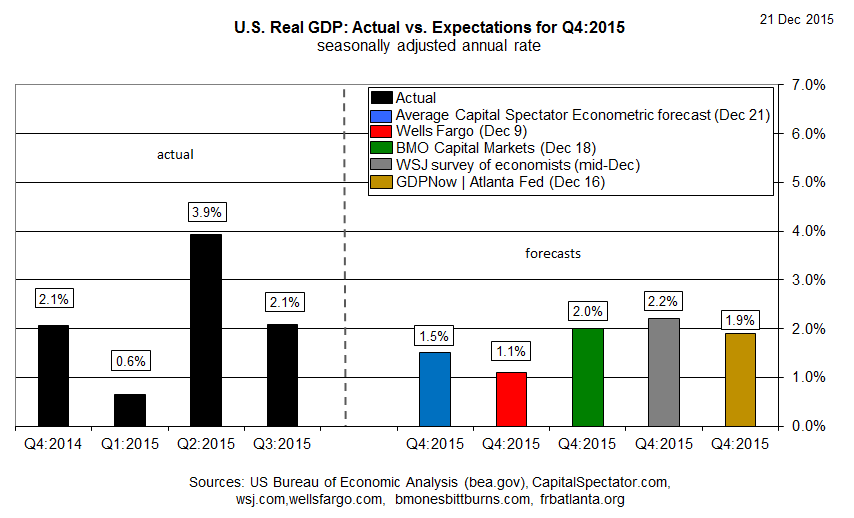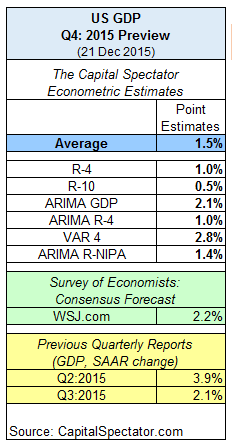US economic growth is on track to decelerate in the fourth quarter, according to The Capital Spectator’s average estimate via several econometric forecasts. Q4 GDP is projected to rise at a sluggish 1.5% rate (seasonally adjusted annual rate), down from the 2.1% advance in Q3.
Today’s updated Q4 estimate represents a modest decline from last month’s 2.0% Q4 prediction.
Forecasts from other sources reflect a relatively wide range of expectations for this year’s final quarter. Among the more optimistic predictions: The Wall Street Journal’s latest survey data, which sees Q4 GDP rising 2.2%–a fractional improvement over Q3–via the average forecast of economists. By contrast, Wells Fargo earlier this month pegged Q4 growth at a weak 1.1% increase.
Meanwhile, Q3 GDP is due for an update tomorrow. Econoday.com’s consensus forecast sees the current 2.1% estimate ticking down to 2.0% when the Bureau of Economic Analysis releases its third estimate for Q3 data on Tuesday, Dec. 22.
Looking ahead to the new year, some economists reason that last week’s approval of a new spending and tax-cut package by Congress could juice growth a bit in 2016 as the federal government offers a degree of fiscal stimulus. “This shift … is currently being overlooked by financial markets and analysts,” opines Joseph Carson, an economist at Alliance Bernstein. “We believe this will be a key aspect of a more positive and faster growth environment for next year.”
As for this year’s Q4 GDP report, which is scheduled to be released on Jan. 29, here’s a review of estimates from various sources:
Here are the various forecasts that are used to calculate CapitalSpectator.com’s average estimate:
As updated estimates are published, based on incoming economic data, the chart below tracks the changes in the evolution of The Capital Spectator’s projections.
Finally, here’s a brief profile for each of The Capital Spectator’s GDP forecast methodologies:
R-4: This estimate is based on a multiple regression in R of historical GDP data vs. quarterly changes for four key economic indicators: real personal consumption expenditures (or real retail sales for the current month until the PCE report is published), real personal income less government transfers, industrial production, and private non-farm payrolls. The model estimates the statistical relationships from the early 1970s to the present. The estimates are revised as new data is published.
R-10: This model also uses a multiple regression framework based on numbers dating to the early 1970s and updates the estimates as new data arrives. The methodology is identical to the 4-factor model above, except that R-10 uses additional factors—10 in all—to forecast GDP. In addition to the data quartet in the 4-factor model, the 10-factor forecast also incorporates the following six series: ISM Manufacturing PMI Composite Index, housing starts, initial jobless claims, the stock market (Wilshire 5000), crude oil prices (spot price for West Texas Intermediate), and the Treasury yield curve spread (10-year Note less 3-month T-bill).
ARIMA GDP: The econometric engine for this forecast is known as an autoregressive integrated moving average. This ARIMA model uses GDP’s history, dating from the early 1970s to the present, for anticipating the target quarter’s change. As the historical GDP data is revised, so too is the forecast, which is calculated in R via the “forecast” package, which optimizes the parameters based on the data set’s historical record.
ARIMA R-4: This model combines ARIMA estimates with regression analysis to project GDP data. The ARIMA R-4 model analyzes four historical data sets: real personal consumption expenditures, real personal income less government transfers, industrial production, and private non-farm payrolls. This model uses the historical relationships between those indicators and GDP for projections by filling in the missing data points in the current quarter with ARIMA estimates. As the indicators are updated, actual data replaces the ARIMA estimates and the forecast is recalculated.
VAR 4: This vector autoregression model uses four data series in search of interdependent relationships for estimating GDP. The historical data sets in the R-4 and ARIMA R-4 models noted above are also used in VAR-4, albeit with a different econometric engine. As new data is published, so too is the VAR-4 forecast. The data sets range from the early 1970s to the present, using the “vars” package in R to crunch the numbers.
ARIMA R-NIPA: The model uses an autoregressive integrated moving average to estimate future values of GDP based on the datasets of four primary categories of the national income and product accounts (NIPA): personal consumption expenditures, gross private domestic investment, net exports of goods and services, and government consumption expenditures and gross investment. The model uses historical data from the early 1970s to the present for anticipating the target quarter’s change. As the historical numbers are revised, so too is the estimate, which is calculated in R via the “forecast” package, which optimizes the parameters based on the data set’s historical record.


